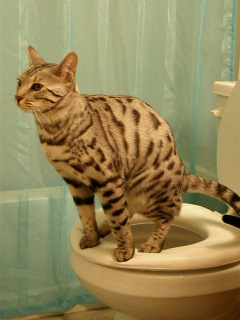Just about everyone has their personal piece of advice on the subject of Don’t flush cat feces down the toilet.

Intro
As pet cat owners, it's necessary to be mindful of just how we dispose of our feline friends' waste. While it might seem convenient to purge feline poop down the toilet, this technique can have damaging consequences for both the setting and human health and wellness.
Alternatives to Flushing
Fortunately, there are much safer and much more liable ways to take care of cat poop. Take into consideration the following choices:
1. Scoop and Dispose in Trash
The most typical approach of dealing with feline poop is to scoop it right into a biodegradable bag and throw it in the trash. Be sure to use a committed trash scoop and get rid of the waste quickly.
2. Use Biodegradable Litter
Choose biodegradable cat trash made from products such as corn or wheat. These litters are environmentally friendly and can be securely taken care of in the garbage.
3. Hide in the Yard
If you have a yard, take into consideration hiding feline waste in a designated location away from veggie gardens and water resources. Make sure to dig deep enough to stop contamination of groundwater.
4. Install a Pet Waste Disposal System
Buy an animal garbage disposal system particularly designed for feline waste. These systems make use of enzymes to break down the waste, decreasing smell and environmental effect.
Wellness Risks
In addition to ecological worries, purging cat waste can additionally posture wellness dangers to human beings. Feline feces may consist of Toxoplasma gondii, a parasite that can create toxoplasmosis-- a potentially extreme disease, especially for expectant women and people with damaged immune systems.
Environmental Impact
Flushing feline poop introduces dangerous microorganisms and bloodsuckers right into the supply of water, presenting a considerable threat to marine communities. These pollutants can negatively impact marine life and concession water top quality.
Final thought
Responsible pet possession extends beyond supplying food and sanctuary-- it additionally entails appropriate waste monitoring. By avoiding purging feline poop down the toilet and selecting different disposal techniques, we can decrease our ecological footprint and shield human health and wellness.
Why Can’t I Flush Cat Poop?
It Spreads a Parasite
Cats are frequently infected with a parasite called toxoplasma gondii. The parasite causes an infection called toxoplasmosis. It is usually harmless to cats. The parasite only uses cat poop as a host for its eggs. Otherwise, the cat’s immune system usually keeps the infection at low enough levels to maintain its own health. But it does not stop the develop of eggs. These eggs are tiny and surprisingly tough. They may survive for a year before they begin to grow. But that’s the problem.
Our wastewater system is not designed to deal with toxoplasmosis eggs. Instead, most eggs will flush from your toilet into sewers and wastewater management plants. After the sewage is treated for many other harmful things in it, it is typically released into local rivers, lakes, or oceans. Here, the toxoplasmosis eggs can find new hosts, including starfish, crabs, otters, and many other wildlife. For many, this is a significant risk to their health. Toxoplasmosis can also end up infecting water sources that are important for agriculture, which means our deer, pigs, and sheep can get infected too.
Is There Risk to Humans?
There can be a risk to human life from flushing cat poop down the toilet. If you do so, the parasites from your cat’s poop can end up in shellfish, game animals, or livestock. If this meat is then served raw or undercooked, the people who eat it can get sick.
In fact, according to the CDC, 40 million people in the United States are infected with toxoplasma gondii. They get it from exposure to infected seafood, or from some kind of cat poop contamination, like drinking from a stream that is contaminated or touching anything that has come into contact with cat poop. That includes just cleaning a cat litter box.
Most people who get infected with these parasites will not develop any symptoms. However, for pregnant women or for those with compromised immune systems, the parasite can cause severe health problems.
How to Handle Cat Poop
The best way to handle cat poop is actually to clean the box more often. The eggs that the parasite sheds will not become active until one to five days after the cat poops. That means that if you clean daily, you’re much less likely to come into direct contact with infectious eggs.
That said, always dispose of cat poop in the garbage and not down the toilet. Wash your hands before and after you clean the litter box, and bring the bag of poop right outside to your garbage bins.
https://trenchlesssolutionsusa.com/why-cant-i-flush-cat-poop/

As a keen person who reads about Can You Flush Cat Poo or Litter Down the Toilet?, I figured sharing that information was worth the trouble. Sharing is good. Helping people is fun. We recognize the value of reading our article about Don’t flush cat feces down the toilet.
Visit My Web Page